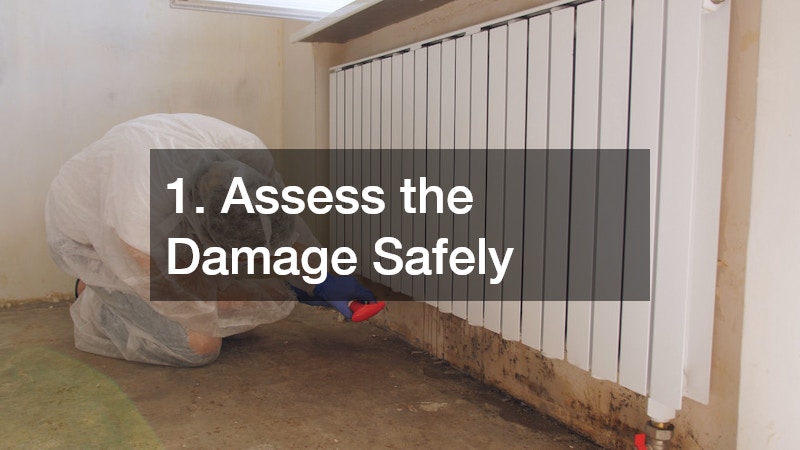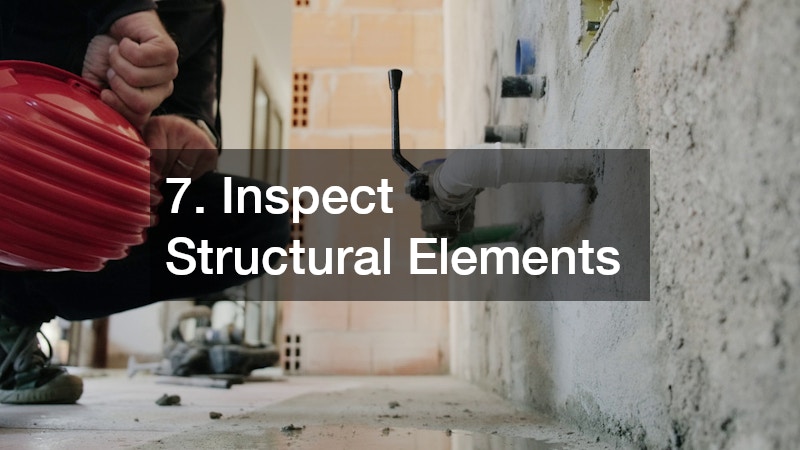Discovering water damage in your home can be both stressful and overwhelming, especially when it happens unexpectedly. It doesn’t take much for a minor leak to turn into a major problem, whether the source is a burst pipe, a leaking roof, or flooding after heavy rainfall. Water intrusion can happen gradually or suddenly, but either way, the effects are often serious if not addressed promptly. Acting quickly is essential to prevent long-term damage that can affect both the safety and value of your home.
Water damage doesn’t just affect the surfaces you can see. It can compromise your home’s structural integrity, weakening walls, ceilings, floors, and even the foundation if moisture is left untreated. Whether it’s dealing with minor leaks, preparing for professional repairs, or taking preventative measures to avoid recurring issues, this guide equips homeowners with the knowledge and steps necessary to manage water emergencies effectively. By understanding what to do immediately and which experts to involve, you can protect your home, maintain its value, and ensure your living environment remains safe and comfortable.
1. Assess the Damage Safely

The first step after discovering water damage is to assess the situation safely. Electrical hazards are a primary concern, so turn off power to the affected area before stepping in. Water and electricity are a dangerous combination, and even small leaks near outlets or wiring can pose serious risks. Once the area is safe, carefully inspect the visible damage. Look for wet floors, walls, ceilings, and furniture, and take note of areas where water may have seeped into hidden spaces. Water often travels along structural elements, so damage may extend further than it appears.
Documenting your observations is critical. Take photos and videos of all affected areas, making sure to capture the full extent of the damage. These records can be invaluable for insurance claims, repair estimates, and contractor assessments. This step is not about fixing the problem yet—it’s about understanding its scope and planning your next moves. Keeping a clear record also ensures you don’t overlook any hidden damage that could worsen over time. A careful assessment lays the foundation for a successful restoration process.
2. Stop the Source of Water
After assessing the damage, the next priority is to stop water from continuing to enter your home. If the cause is a burst pipe or plumbing issue, shutting off the main water valve is essential. If the damage is due to rain or roof leaks, temporary measures like towels, buckets, or tarps can help contain the flow until professional help arrives. Prompt action can significantly reduce the extent of water damage and protect areas that haven’t yet been affected.
Even minor leaks should be addressed immediately. Continuous dripping or seepage can saturate building materials, leading to swelling, warping, or rot. Temporary solutions are only a short-term fix, so contacting a professional for a permanent repair is crucial. In addition to stopping the water, monitor surrounding areas for signs of spread. Water can travel quickly along floors, walls, and ceilings, reaching places you might not expect. Taking action early saves time, reduces repair costs, and prevents secondary damage such as mold growth.
3. Call an Expert

If your water damage is caused by plumbing issues, contacting a plumber immediately is one of the most important steps. Professional plumbers can quickly locate leaks, identify damaged pipes, and implement effective repairs. A burst pipe or broken fixture can worsen rapidly if left untreated, making professional intervention essential. Attempting DIY fixes for significant plumbing problems can sometimes make the issue worse, leading to more extensive water damage and higher repair costs.
A plumber will also assess the underlying cause of the leak. In some cases, recurring leaks indicate old or corroded pipes, poor connections, or issues with water pressure. Addressing the root cause prevents future problems and provides peace of mind. Once the plumber has stopped the leak and repaired any damaged plumbing, you can begin the next stages of cleanup and restoration with confidence. Prompt professional support ensures that water damage does not continue unchecked, protecting both your home’s structure and your family’s safety.
4. Remove Excess Water
Removing standing water is critical to preventing long-term damage. Water left in floors, carpets, and other surfaces can seep into walls, foundations, and insulation. Even small amounts of residual water can encourage mold growth, wood rot, and unpleasant odors. For minor leaks, towels, mops, and buckets can be sufficient. For larger floods, professional water extraction equipment is recommended to speed up the process.
Using specialized tools like wet vacuums or submersible pumps can make a significant difference, especially in basements or large living areas. Taking the time to remove water thoroughly helps prevent secondary damage and creates a safer environment for cleanup. It’s also essential to dispose of water safely and avoid spreading contaminants. For particularly sensitive areas, consider contacting professional carpet cleaning services. These experts can remove excess moisture from carpets and upholstery, sanitize affected surfaces, and help prevent mold or mildew from taking hold. Proper removal of standing water lays the foundation for effective drying and restoration.
5. Protect Your Belongings

Once water removal is underway, focus on protecting your belongings. Move furniture, electronics, and valuables out of the affected area, placing items on raised surfaces or plastic sheets to avoid further exposure. Wet items are susceptible to permanent damage if left in water, and early action can significantly reduce losses. Consider separating items that may require professional cleaning, such as rugs, upholstered furniture, or important documents.
In addition to physical protection, proper handling can reduce the spread of water and contaminants throughout your home. For textiles, carpets, and rugs, professional carpet cleaning services can sanitize and restore items that would otherwise be damaged. Electronics and appliances may require specialist inspection before reuse. Protecting your belongings is not just about minimizing loss—it also reduces stress and creates a safer, more manageable workspace for the restoration process. Prioritizing what to save first can make cleanup far more efficient and less overwhelming.
6. Dry Out the Area Thoroughly
Even after removing standing water, moisture often remains in hidden spaces like walls, floors, and ceilings. Thorough drying is essential to prevent mold growth and structural damage. Use fans, dehumidifiers, and proper ventilation to accelerate the drying process. Monitor progress carefully, and check areas that are not immediately visible. Water can travel through cavities, baseboards, and wall joints, leaving damp spots that require attention.
For carpets, rugs, and furniture, professional carpet cleaning services often provide deep-drying and sanitization solutions. For walls or structural components, using moisture meters can help detect lingering dampness. The goal is to ensure every affected surface is completely dry before repairs begin. Failing to dry the area thoroughly increases the risk of mold, mildew, and deterioration of building materials. Adequate drying also creates a safer environment for contractors and homeowners to continue restoration work, minimizing long-term health risks.
7. Inspect Structural Elements

Water can compromise structural elements like floors, walls, ceilings, and foundations. Look for sagging, cracks, bulging drywall, or discoloration. These issues indicate deeper damage that may require professional intervention. In some cases, a retaining wall contractor may need to evaluate exterior walls or landscaping features contributing to water intrusion. Even minor cracks can allow additional water to seep in if left untreated.
Inspecting structural elements thoroughly ensures that you address the root cause of water damage rather than just surface symptoms. If damage extends to the foundation or framing, delays in repair can lead to significant long-term costs. Structural inspection also provides valuable insight into whether additional preventative measures, such as basement waterproofing service, are necessary. Catching these issues early allows you to plan repairs strategically, protecting the home’s integrity and maintaining property value.
8. Evaluate Your Roof and Gutters
Leaking roofs and clogged gutters are common contributors to water damage. A roofer can inspect shingles, flashing, and valleys for leaks, while seamless gutters services ensure proper water flow away from the home. Blocked or damaged gutters can redirect rainwater toward your foundation, leading to basement flooding or wall seepage.
Regular inspection and maintenance of roofs and gutters are essential. Removing debris, checking for damaged sections, and ensuring proper drainage can prevent future water intrusion. These preventative steps complement other measures like french drain service or landscaping adjustments, helping protect your home from both minor leaks and severe storms. Investing in professional evaluation and maintenance ensures long-term protection and peace of mind.
9. Check Exterior Drainage
Exterior drainage is often overlooked, yet it plays a major role in water damage prevention. Water pooling near your home’s foundation can cause basement leaks and structural issues. Installing or repairing a french drain service can redirect water safely away from your home. In addition, hiring a landscaper to regrade your yard or install proper drainage features ensures water flows away from your foundation.
Effective exterior drainage works hand in hand with other preventative measures. Soil grading, retaining walls, and landscaping features should all channel water away from vulnerable areas. These steps help prevent recurring water problems and reduce stress on your home’s structure. Coordinating with professionals ensures that both functional and aesthetic aspects of your property are addressed. Proactive drainage management is essential for long-term water damage prevention and can save thousands in potential repairs.
10. Repair and Restore Affected Areas
Once the area is dry and assessed, restoration can begin. Professional siding contractors can repair exterior damage, which may involve replacing drywall, insulation, flooring, or furniture. Completing repairs thoroughly ensures that your home is safe, functional, and protected against future water issues. You can count on asphalt crack sealers to prevent water from seeping into driveways and surrounding areas.
Water damage repair also involves taking preventative measures for the future. Combining repairs with solutions like basement waterproofing service, professional carpet cleaning, and regular gutter maintenance reduces the risk of repeat incidents. Restoration isn’t just about fixing what’s broken—it’s about building a more resilient home. Engaging the right contractors and completing all recommended repairs protects your investment, maintains property value, and provides peace of mind for you and your family.
Water damage can feel overwhelming, but following these ten steps helps homeowners regain control and prevent further problems. Start by carefully assessing the damage to understand the full scope and ensure it’s safe to proceed. Once you know what you’re dealing with, stopping the water source is crucial, whether that means shutting off a pipe, redirecting runoff, or containing leaks with temporary barriers. Documenting the situation with photos and notes is also important, both for insurance purposes and to help professionals understand the extent of the damage.
Engaging the right professionals can make a significant difference in the restoration process. A plumber can locate and repair leaks that may be hidden behind walls or under floors, preventing additional flooding. For roofing issues, a roofer can inspect and repair damaged shingles or flashing to stop future leaks. If exterior walls or soil are contributing to water intrusion, a retaining wall contractor can provide structural reinforcement, while siding contractors ensure your home’s exterior is properly sealed and protected. For yard grading and drainage improvements, a landscaper can redirect water away from your foundation, reducing the risk of repeated damage.
After addressing immediate concerns, removing standing water is critical to avoid further structural harm and mold growth. Using fans, dehumidifiers, and professional carpet cleaning services can help dry floors and furnishings efficiently. Thoroughly inspecting structural elements, such as floors, walls, and ceilings, ensures that hidden moisture does not compromise the home’s integrity. Finally, completing repairs along with preventative measures—such as basement waterproofing service, seamless gutters services, french drain service, and asphalt crack sealers where needed—helps protect your home from future water damage. By taking these steps carefully and systematically, homeowners can restore safety, preserve property value, and reduce stress caused by water damage.
Proactive action—combined with professional support such as seamless gutters services, french drain service, asphalt crack sealers, and carpet cleaning—reduces long-term damage and restores your home efficiently. These steps provide practical guidance and peace of mind, helping you navigate water damage with confidence. Early action prevents costly repairs, protects your property, and safeguards the health and safety of your family.
